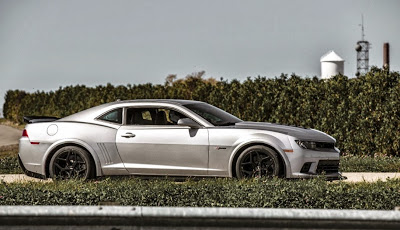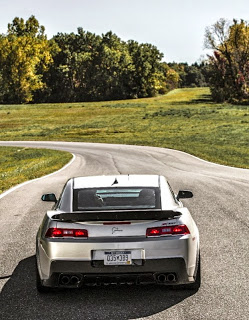“One of the challenges of testing at the ‘Ring is that the track is so long that conditions can change radically in a single lap,” said Al Oppenheiser, Camaro chief engineer. “Adam Dean, the development driver for Z/28, did a heroic job driving in deteriorating conditions. Based on telemetry data from our test sessions, we know the production Z/28 can be as much
as six seconds faster on a dry track.”
In terms of lap times, the Z/28’s improved speed came from three areas:
• Increased grip: The Z/28 is capable of 1.08 g in cornering acceleration, due to comprehensive chassis revisions
• Increased stopping power: The Z/28 features Brembo carbon-ceramic brakes capable of
1.5 g in deceleration, and consistent brake feel lap after lap
• Reduced curb weight: The naturally aspirated Z/28 weighs 300 pounds less than
the supercharged Camaro ZL1, with changes ranging from lightweight wheels to
thinner rear-window glass.
The heart of the Z/28 is the 7.0L LS7 engine. The LS7 uses lightweight, racing-proven, high-performance components, including titanium intake valves and connecting rods, CNC-ported aluminum cylinder heads and a forged-steel crankshaft. Output is SAE-certified at 505 horsepower, 481 foot-pounds of torque. Air-conditioning is available, only as an option.
A close-ratio six-speed manual transmission is the only transmission offered and power is distributed to the rear wheels via a limited-slip differential featuring a helical gear set, rather than traditional clutch packs. The new design enables the driver to apply more power and get through corners faster, by making the most of the capability of individual-wheel anti-lock brake function during corner entry braking, mid-corner speed and corner-exit traction.
Chevrolet’s team spent a week at the Nürburgring as part of the Z/28’s performance-validation regimen, accumulating a total of 10 hours and nearly 1,000 miles on the track. Each lap took less than eight minutes to complete, despite having to overtake slower traffic at times. These hours are part of the grueling 24-Hour Test, which simulates a full year’s worth of track use of track days or amateur-level competition.
“Passing the 24-Hour Test is a requirement for all cars we call track capable,” said Wayne McConnell, director of global vehicle performance. “The test pushes the car at 10/10ths on the track for a total of 24 hours. During the test the only mechanical changes allowed are replacing the brakes and tires.”
The 24-Hour Test is broken into a number of segments over the course of several days – and even at different tracks – to evaluate performance in precisely measured and carefully monitored increments. Crucially, each valid test lap must be run within two-percent of a target lap speed to count toward the 24-hour total.
“Today’s test pushes the car harder than the vast majority of customers ever will. As a result, when we call a car track capable we are confident that it will perform reliably and consistently for our customers.”
For the latest information on 2014 Camaros, please visit http://www.chevrolet.com/camaro-sport-coupe.html







